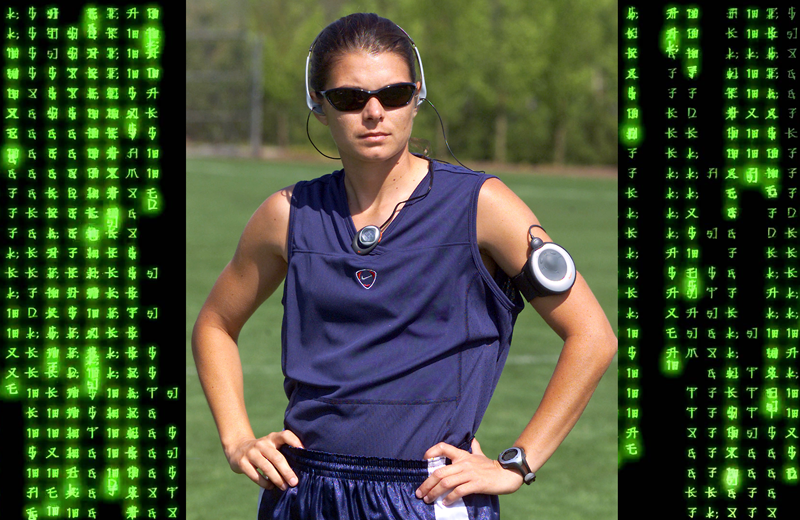The proliferation of mp3 players has made training to personal musical accompaniment easy. But despite the capacity to create specific playlists, anecdotal evidence suggests that the order of athletes’ mp3 playlist tracks is far from systematic. Dan Bishop invites you to buck the trend.
The direction of your attention at any one point during competition or training can be broadly classified into one of two types(1). An associative style entails paying attention to aspects of your performance such as cadence, breathing, your opponents, etc. A dissociative style reflects non-performance-related thoughts, such as tomorrow’s shopping obligations, a conversation you had the previous day, thinking how pretty the trees look, etc.
Some evidence suggests that elite runners adopt predominantly associative strategies while running, whereas novices tend towards dissociation(2,3). However, to maintain an associative focus during a very long event would be mentally exhausting – and therefore potentially counterproductive. The relative merits and drawbacks of both styles are listed in table 1.
In recovery, a better strategy may be to ‘switch off’ and dissociate from training. However, without a salient external focus (eg an engaging television programme), it can be difficult to do so for more than a few minutes. Fortunately, listening to emotive music is a powerful means by which you can exert control over your attentional focus in a subtle yet surprisingly controlled manner, to optimise your performance. Recent research suggests that a number of factors influence our emotional responses to music, and that may these impact on one’s attentional focus when competing (5,6).
Music, emotion and attention
Before considering the relationship between music, emotion and attention, we should define what an emotion is. Emotions are more than feelings; they’re a comprehensive brain-body response to events in our environment, which should facilitate our performance in – and interaction with – that environment. I use the word should because sometimes things can go wrong. For example, a triathlete may become over-aroused at the start of what he or she perceives to be a personally important race, leading to a far too fast start in the swim, leading to potentially catastrophic consequences for the rest of the race.Our emotional responses to music are affected by a number of factors, all of which may affect our subsequent attentional focus in varying ways, and to varying degrees:
Intrinsic factors are the acoustical and physical properties of the music, such as the harmony or tempo;
Extrinsic factors are ‘external’ things such as extra-musical associations (eg memories of a loved one which have become inextricably attached to a particular song).
Extrinsic factors dictate the content of our emotional responses to music (eg whether we consider them pleasant or not), whereas intrinsic factors determine the intensity of that response (ie how aroused/energised we feel). Two intrinsic factors that have a profound impact on our emotional responses to music are its tempo and volume.
The effect of these two variables on athletes’ emotional responses and athletic performance has received a good deal of attention from researchers at Brunel University in London. They found that pre-performance music played at faster tempi induced more positive and aroused emotional states in athletes; higher music volumes also increased arousal(7). In addition, faster tempi are more preferred when exercising at higher intensities, and also contribute to superior sprint rowing performance(8,9). Music played at a faster tempo and a loud volume may therefore be preferable when higher arousal and increased work output are required during intense efforts, perhaps by promoting an ergogenic associative attentional focus.
The rhythmicity of music heard is also highly motivating. A track with a strong rhythm whose tempo is similar to that of the activity we are performing can enhance sprint performance, by diverting attention towards maintenance of stride rate(10). We also instinctively orient ourselves away from discordant/disharmonious music(11) and this fact can be exploited: when listening to a fast, strongly rhythmic yet discordant track, explosive performance may be enhanced.
For example, the former 400m runner Iwan Thomas. Iwan reportedly listened to The Prodigy’s Firestarter when performing rigorous training sessions, to give him that extra zip and it clearly worked! The lyrics were also a likely contributory factor in this instance, conjuring up the idea of something/someone quite aggressive and mischievous; lyrics have also been mooted as an important consideration when selecting performance music(12).
A key consequence of listening to performance music is visual imagery, which can be thought of as seeing things in the mind’s eye, or even daydreaming(5). Music that brings to mind non-performance-related images is likely to promote dissociation, whereas musically-induced performance-related images will tend to produce association.
The pairing of a music track with extrinsic sources of emotion such as a film, artist’s video or a memorable life event is also an important consideration. Many of these connections happen unwittingly, indelibly pinning a track to a specific point or set of memories in time. However, such links can also be created deliberately. Researchers at Brunel University have shown that not only do ‘personal highlight music videos’ enhance athletes’ feelings of accomplishment and subsequent performance, but they also increase physiological indices of arousal(13,14). Table 2 provides some research-based suggestions to consider for intrinsic and extrinsic factors when optimising your music for different types of training session or race.
Riding the attentional rollercoaster: case study of a marathoner(6)
Joe (a pseudonym) was a regular sub-3 hour marathoner aiming to go under 2:45:00. He was also an avid music consumer, and had tended towards overly fast starts and inconsistent pacing in his recent races, including an important marathon event. Joe’s goal was to control his start and to maintain a consistent pace throughout this event in the following year.He had spent considerable time in developing a playlist of his 26 most emotive running music tracks on his mp3 player, which permanently played in ‘random’ mode. Nonetheless, we decided to search for ways in which the play order could be optimised to moderate his pacing. I interviewed Joe extensively to identify (a) intrinsic and extrinsic factors contributing to his emotional responses, and (b) his predominant resultant attentional focus for each.
A useful tool in sensitising Joe to his emotional responses was the Affect Grid (see figure 1)(15). This measure comprises two perpendicular scales: ‘pleasantness’ and ‘arousal’. Proponents of such ‘dimensional models’ contend that all of our emotional responses display these two components and that our decision to approach or avoid something (related to pleasantness), and the resources we invest in doing so (related to arousal) are fundamental to such responses.
While listening to each of his 26 playlist tracks, Joe marked a cross in one box of the 9 x 9 grid to denote his emotional response; individual scores for arousal and pleasantness were then derived. Those tracks that Joe perceived as the most arousing were identified as a starting point for discussion: what did they prompt him to think about? In other words, did they cause him to associate with the running process; or did they prompt a more dissociative style? Because of their strongly arousing nature, these tracks were likely to be the most effective for directing Joe’s attentional focus.
We subsequently examined the pleasantness of the playlist tracks. Clearly, he was unlikely to rate any tracks as unpleasant, but we explored the reasons underlying selection of those rated as most pleasant. These were often a combination of intrinsic factors such as fast tempo, fun lyrics, etc, and extrinsic sources such as happy life events.
We were now in a position to identify two relatively low-arousal tracks with which Joe had no strong associations. I instructed him to listen to these two tracks repeatedly as he practised his start pacing, during track training. I also encouraged him to close his eyes as frequently as possible when performing this exercise, to attune him to the kinaesthetic cues coming from his limbs (a pivotal factor in prompting his quick starts was his becoming swept along with faster runners). These two tracks consequently came to engender a strong inward associative focus, the aim of which was to enable Joe to become very focused on a correctly-paced start via classical conditioning (as in Pavlov’s dogs!).
We also agreed that some strong switching-off/dissociation was necessary immediately after this controlled, associative start, to lessen the inevitable anxiety resulting from Joe’s preoccupation with his performance. Therefore, I asked him to select three tracks which (a) possessed high arousal potential and (b) invoked strong non-performance-related memories and/or imagery. For the remaining 21 tracks, we used the inescapable art-meets-science approach that regularly occurs in such applied interventions, to create some fluctuation of Joe’s attentional focus. I dubbed the resultant profile ‘The Attentional Rollercoaster’, because of its resemblance to that of a rollercoaster track (see figure 2).
Table 3 shows Joe’s split times for the two marathons (pre- [M1] and post-intervention [M2]). Three things are quickly apparent: (i) his start in M2 was over one minute slower than for M1, (ii) the decline in his pace over the course of M2 was considerably less than for M1 and (iii) his new time – crucially – was under 2:45:00. Joe gained entry to the UK Championship, and attributes much of his performance gains to his revamped playlist.
Dr Dan Bishop, CPsychol is a lecturer and researcher at Brunel University in West London, UK.
References
1. Sports Performance Bulletin. 1998 June; 105:1-2
2. Track and Field Quarterly Review. 1977 June; 77: 46
3. Marathon: physiological, medical, epidemiological, and psychological studies. 1977 Nov; 4: 382-403
4. J Sp Psych. 1985 Feb; 7: 371-378
5. J Sp & Ex Psych. 2007 Oct; 29: 584-607
6. Eur Fed Sp Psych Annual Congress. 2007 Sept
7. The Sp Psych (under review)
8. J Sp & Ex Psych (under review)
9. The Sp Psych. 2008 Jul; 22: 175-182
10. J Sp Sci. 2006 Oct; 24: 1095-1102
11. Nature. 1996 Nov; 383: 29
12. Journal of Sport Behavior. 1997, Oct; 20: 54-68
13. BASES Ann Conf. 2006 Sept
14. BASES Ann Conf. 2008 Sept
15. J of Pers & Soc Psych. 1989 Apr; 57: 493-502









